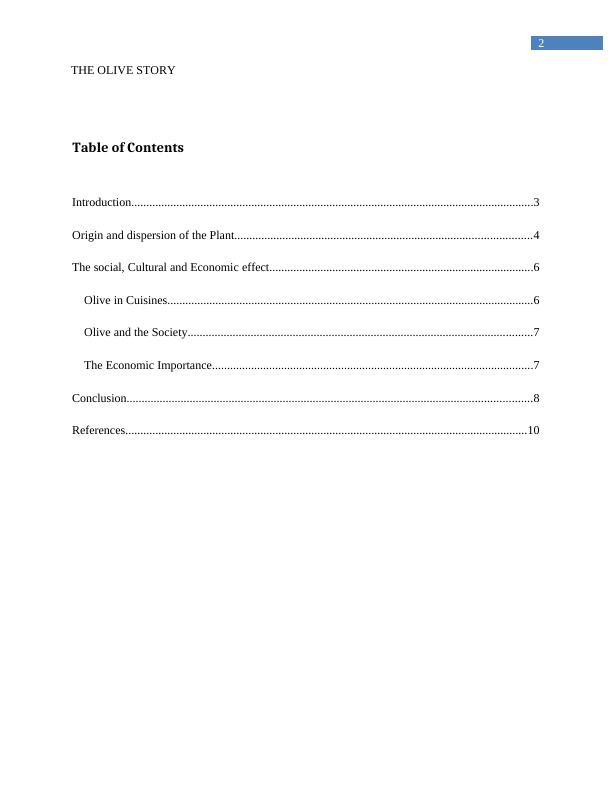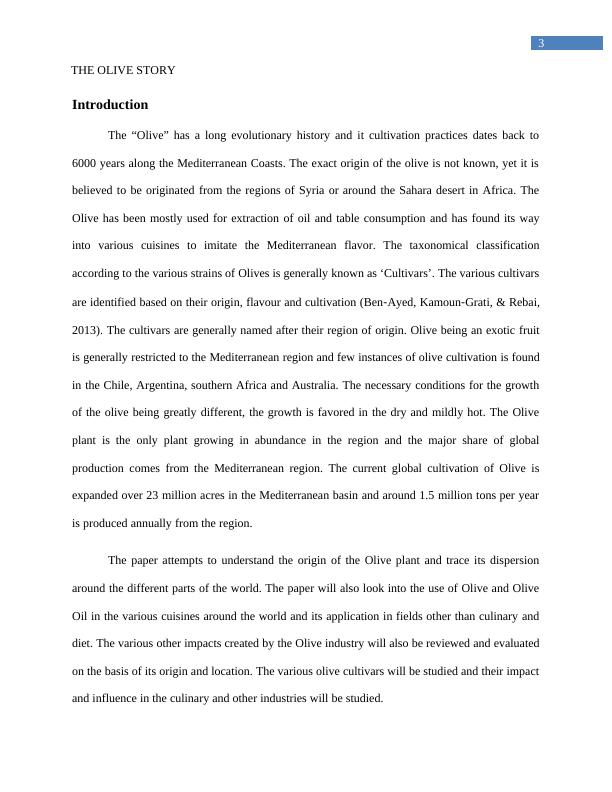Ask a question from expert
Geo 509: Food, Place and Identity
11 Pages2770 Words102 Views
Food, Place and Identity (Geo 509)
Added on 2021-09-17
Geo 509: Food, Place and Identity
Food, Place and Identity (Geo 509)
Added on 2021-09-17
BookmarkShareRelated Documents
Running head: THE OLIVE STORY
THE OLIVE STORY
Name of the Student
Name of the University
Author Note
THE OLIVE STORY
Name of the Student
Name of the University
Author Note

2
THE OLIVE STORY
Table of Contents
Introduction......................................................................................................................................3
Origin and dispersion of the Plant...................................................................................................4
The social, Cultural and Economic effect........................................................................................6
Olive in Cuisines..........................................................................................................................6
Olive and the Society...................................................................................................................7
The Economic Importance...........................................................................................................7
Conclusion.......................................................................................................................................8
References......................................................................................................................................10
THE OLIVE STORY
Table of Contents
Introduction......................................................................................................................................3
Origin and dispersion of the Plant...................................................................................................4
The social, Cultural and Economic effect........................................................................................6
Olive in Cuisines..........................................................................................................................6
Olive and the Society...................................................................................................................7
The Economic Importance...........................................................................................................7
Conclusion.......................................................................................................................................8
References......................................................................................................................................10

3
THE OLIVE STORY
Introduction
The “Olive” has a long evolutionary history and it cultivation practices dates back to
6000 years along the Mediterranean Coasts. The exact origin of the olive is not known, yet it is
believed to be originated from the regions of Syria or around the Sahara desert in Africa. The
Olive has been mostly used for extraction of oil and table consumption and has found its way
into various cuisines to imitate the Mediterranean flavor. The taxonomical classification
according to the various strains of Olives is generally known as ‘Cultivars’. The various cultivars
are identified based on their origin, flavour and cultivation (Ben‐Ayed, Kamoun‐Grati, & Rebai,
2013). The cultivars are generally named after their region of origin. Olive being an exotic fruit
is generally restricted to the Mediterranean region and few instances of olive cultivation is found
in the Chile, Argentina, southern Africa and Australia. The necessary conditions for the growth
of the olive being greatly different, the growth is favored in the dry and mildly hot. The Olive
plant is the only plant growing in abundance in the region and the major share of global
production comes from the Mediterranean region. The current global cultivation of Olive is
expanded over 23 million acres in the Mediterranean basin and around 1.5 million tons per year
is produced annually from the region.
The paper attempts to understand the origin of the Olive plant and trace its dispersion
around the different parts of the world. The paper will also look into the use of Olive and Olive
Oil in the various cuisines around the world and its application in fields other than culinary and
diet. The various other impacts created by the Olive industry will also be reviewed and evaluated
on the basis of its origin and location. The various olive cultivars will be studied and their impact
and influence in the culinary and other industries will be studied.
THE OLIVE STORY
Introduction
The “Olive” has a long evolutionary history and it cultivation practices dates back to
6000 years along the Mediterranean Coasts. The exact origin of the olive is not known, yet it is
believed to be originated from the regions of Syria or around the Sahara desert in Africa. The
Olive has been mostly used for extraction of oil and table consumption and has found its way
into various cuisines to imitate the Mediterranean flavor. The taxonomical classification
according to the various strains of Olives is generally known as ‘Cultivars’. The various cultivars
are identified based on their origin, flavour and cultivation (Ben‐Ayed, Kamoun‐Grati, & Rebai,
2013). The cultivars are generally named after their region of origin. Olive being an exotic fruit
is generally restricted to the Mediterranean region and few instances of olive cultivation is found
in the Chile, Argentina, southern Africa and Australia. The necessary conditions for the growth
of the olive being greatly different, the growth is favored in the dry and mildly hot. The Olive
plant is the only plant growing in abundance in the region and the major share of global
production comes from the Mediterranean region. The current global cultivation of Olive is
expanded over 23 million acres in the Mediterranean basin and around 1.5 million tons per year
is produced annually from the region.
The paper attempts to understand the origin of the Olive plant and trace its dispersion
around the different parts of the world. The paper will also look into the use of Olive and Olive
Oil in the various cuisines around the world and its application in fields other than culinary and
diet. The various other impacts created by the Olive industry will also be reviewed and evaluated
on the basis of its origin and location. The various olive cultivars will be studied and their impact
and influence in the culinary and other industries will be studied.

4
THE OLIVE STORY The methodology followed for the research will be done mostly on peer reviewed
journals from secondary sources. No primary sources or field visits will be done for the research.
The research will also be done based on culinary experiences across the world and evaluating
cuisines based on olive and its application. The Olive production is one of the major sources of
economy for the Mediterranean countries and the global production is also controlled on the
basis of the production in this region.
Origin and dispersion of the Plant
The origin of the Olive Plant is believed to be in the sub tropical region which
experiences moderate climate with very less amount of wet seasons. The regional flora is largely
restricted and Olive being the abundant vegetation in the region got predominantly cultivated.
Evidences of Olive has been found since Neolithic age and traces were found in the
Mesopotamian civilization, the Egyptian civilization and Greeks and the Romans were believed
to use to it extensively and gave high importance to the plant. Tough the exact origin of the tree
cannot be traced back, extremely ancient archeological evidences are found that prove the use of
Olives and Olive oils in the region. By the time the plant was being was being extensively
utilised by the Romans and the later the Arabs, the Olive tree had already established its
dominance in the region. The plant was extensively used and was dedicated to Greek Gods to
reflect its high importance (Adoptyourolivetree.com. 2018). The initial dispersion of the Olive
tree is believed to be done by the Greeks by trading to other civilizations and to their colonies.
The expansions of the farming of Olive trees were first done by the Romans in the Iberian
Peninsula currently included in the parts of Spain and Portugal. The later expansion of the Olive
production was later promoted by initial imports from Greece, Italy, Spain and Portugal. The
THE OLIVE STORY The methodology followed for the research will be done mostly on peer reviewed
journals from secondary sources. No primary sources or field visits will be done for the research.
The research will also be done based on culinary experiences across the world and evaluating
cuisines based on olive and its application. The Olive production is one of the major sources of
economy for the Mediterranean countries and the global production is also controlled on the
basis of the production in this region.
Origin and dispersion of the Plant
The origin of the Olive Plant is believed to be in the sub tropical region which
experiences moderate climate with very less amount of wet seasons. The regional flora is largely
restricted and Olive being the abundant vegetation in the region got predominantly cultivated.
Evidences of Olive has been found since Neolithic age and traces were found in the
Mesopotamian civilization, the Egyptian civilization and Greeks and the Romans were believed
to use to it extensively and gave high importance to the plant. Tough the exact origin of the tree
cannot be traced back, extremely ancient archeological evidences are found that prove the use of
Olives and Olive oils in the region. By the time the plant was being was being extensively
utilised by the Romans and the later the Arabs, the Olive tree had already established its
dominance in the region. The plant was extensively used and was dedicated to Greek Gods to
reflect its high importance (Adoptyourolivetree.com. 2018). The initial dispersion of the Olive
tree is believed to be done by the Greeks by trading to other civilizations and to their colonies.
The expansions of the farming of Olive trees were first done by the Romans in the Iberian
Peninsula currently included in the parts of Spain and Portugal. The later expansion of the Olive
production was later promoted by initial imports from Greece, Italy, Spain and Portugal. The

End of preview
Want to access all the pages? Upload your documents or become a member.